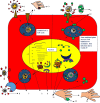Green Synthesis-Mediated Nanoparticles and Their Curative Character Against Post COVID-19 Skin Diseases
- PMID: 36105411
- PMCID: PMC9461414
- DOI: 10.1007/s40495-022-00303-x
Green Synthesis-Mediated Nanoparticles and Their Curative Character Against Post COVID-19 Skin Diseases
Abstract
Purpose of review: This article provides the explanatory manuscript regarding the SARS-Corona virus 2. Sub-titled as the history of single-stranded RNA, internal characters of COVID-19, resource, the life cycle of COVID-19, reservoir of the disease, secondary infections of COVID-19 and nano herbal remedy.
Recent findings: The skin is not the main target of the SARS-corona virus 2 infections but somehow directly or indirectly, it causes exacerbating eruptions on the skin. Recent research shows that curcumin-mediated synthesized AgNPs show its potential character in the entry of respiratory syncytial virus (RSV), blocks interaction with the viral surface, and damages the viral protein. In modern days, molecular docking studies fabricated copper iodide flower extract (CuI-FE) which shows tough inhibitory action against COVID-19. Many articles show green synthesis-mediated nanoparticles like silver, gold, zinc, copper, iron, titanium dioxide, selenium, and cadmium which possess high anti-viricidal activity.
Summary: The anti-oxidant, anti-viral, anti-inflammatory, anti-hive rich plant-mediated nanoparticle synthesis might be an alternative betterment, cost-effective, and eco-friendly medication for the skin disease caused by SARS-corona virus 2 (the viral clinical signs are itchy, hives, rashes, papules, psoriasis, and inflammation) and (non-viral clinical signs-pressure urticaria, contact dermatitis, and acne) that occurred as the result of COVID-19.
Keywords: Anti-hives; Coronavirus; Cuticular; Pandemic; Phytotherapeutic; Reservoir.
© The Author(s), under exclusive licence to Springer Nature Switzerland AG 2022, Springer Nature or its licensor holds exclusive rights to this article under a publishing agreement with the author(s) or other rightsholder(s); author self-archiving of the accepted manuscript version of this article is solely governed by the terms of such publishing agreement and applicable law.
Conflict of interest statement
Conflict of InterestThe authors declare no conflict of interest. Human and Animal Rights and Informed Consent. This article does not contain any studies with human or animal subjects performed by any of the authors.
Figures

Similar articles
-
Application of green synthesised copper iodide particles on cotton fabric-protective face mask material against COVID-19 pandemic.J Mater Res Technol. 2021 Nov-Dec;15:2102-2116. doi: 10.1016/j.jmrt.2021.09.020. Epub 2021 Sep 14. J Mater Res Technol. 2021. PMID: 35864980 Free PMC article.
-
Plant-mediated green synthesis of metal-based nanoparticles for dermopharmaceutical and cosmetic applications.Int J Pharm. 2021 Mar 15;597:120311. doi: 10.1016/j.ijpharm.2021.120311. Epub 2021 Feb 1. Int J Pharm. 2021. PMID: 33539998 Review.
-
Selective cytotoxicity of green synthesized silver nanoparticles against the MCF-7 tumor cell line and their enhanced antioxidant and antimicrobial properties.Int J Nanomedicine. 2018 Nov 27;13:8013-8024. doi: 10.2147/IJN.S189295. eCollection 2018. Int J Nanomedicine. 2018. PMID: 30568442 Free PMC article.
-
Green synthesis of biogenic silver nanoparticles using Solanum tuberosum extract and their interaction with human serum albumin: Evidence of "corona" formation through a multi-spectroscopic and molecular docking analysis.J Photochem Photobiol B. 2017 Aug;173:108-119. doi: 10.1016/j.jphotobiol.2017.05.015. Epub 2017 May 15. J Photochem Photobiol B. 2017. PMID: 28570906
-
Eco-friendly approach for nanoparticles synthesis and mechanism behind antibacterial activity of silver and anticancer activity of gold nanoparticles.Appl Microbiol Biotechnol. 2017 Jan;101(1):79-92. doi: 10.1007/s00253-016-8012-8. Epub 2016 Dec 3. Appl Microbiol Biotechnol. 2017. PMID: 27915376 Review.
Cited by
-
Dermatological complications due to post‑COVID‑19 syndrome: A systematic review.Med Int (Lond). 2024 Nov 26;5(1):9. doi: 10.3892/mi.2024.208. eCollection 2025 Jan-Feb. Med Int (Lond). 2024. PMID: 39640203 Free PMC article.
References
-
- Chen C, Zhang XR, Ju ZY, He WF. Advances in the research of cytokine storm mechanism induced by corona virus disease 2019 and the corresponding immunotherapies. Zhonghua Shaoshang Zazhi. 2020;36:5. - PubMed
Publication types
LinkOut - more resources
Full Text Sources
Research Materials
Miscellaneous
